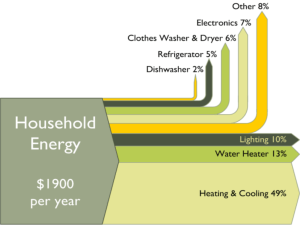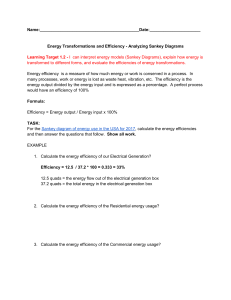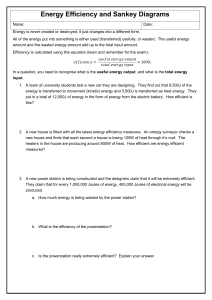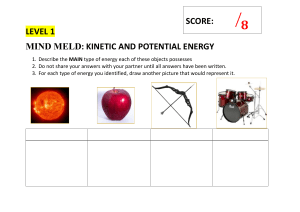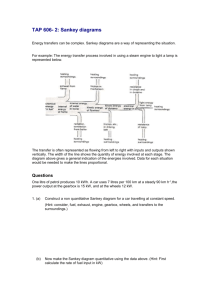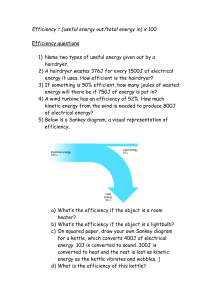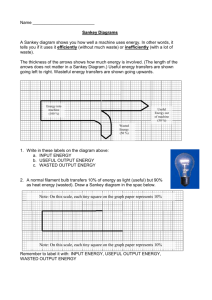Energy Conservation & Efficiency: Presentation
advertisement
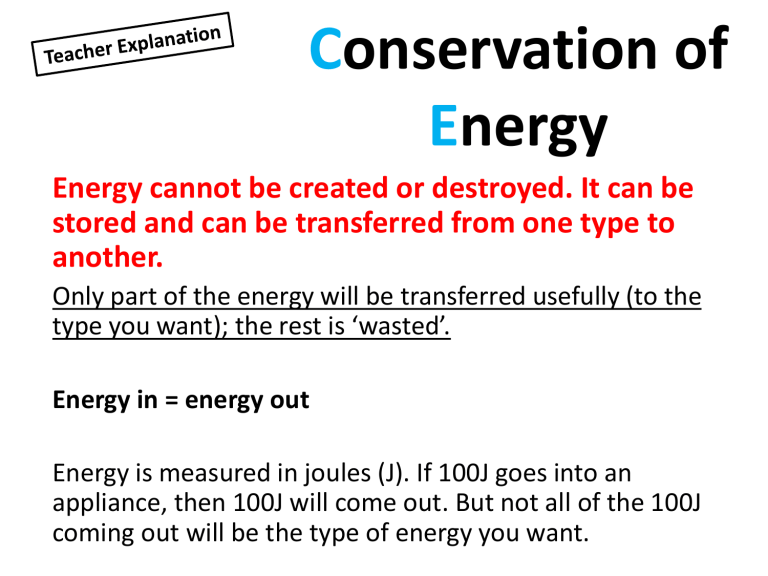
Conservation of Energy Energy cannot be created or destroyed. It can be stored and can be transferred from one type to another. Only part of the energy will be transferred usefully (to the type you want); the rest is ‘wasted’. Energy in = energy out Energy is measured in joules (J). If 100J goes into an appliance, then 100J will come out. But not all of the 100J coming out will be the type of energy you want. Appliance Input Useful Waste energy (J) energy (J) Energy (J) Tungsten filament light bulb 100 20 80 Energy efficient light bulb 25 20 5 Electric kettle 200 180 20 Electric drill 500 300 200 Old washing machine 500 200 300 New washing machine 300 200 100 New energy efficient washing machine 250 200 50 Time Available: 5 mins Gr C: 3 Completed Gr B: 5 Completed Gr A: All 7 Completed Efficiency Efficiency tells us how much useful energy we get out compared to how much wasted energy we get out. The greater the amount of energy converted to the type of energy you want the more efficient it is. We can calculate this using the following equation; Efficiency We can calculate this using the following equation; Example A kettle has 1000 joules of input electrical energy and produces 200 joules of useful heat energy. The rest is wasted as sound. Work out the efficiency. Energy Input = 1000 J useful Energy OUTPUT = 200 J (200 / 1000) X 100 0.2 X 100 = 20% efficiency Why Are They Called Sankey Diagrams? Captain Matthew Henry Phineas Riall Sankey was an engineer. In 1898 he was the first person to publish a diagram that used the width of an arrow to show the size of the energy flow. The first ever Sankey diagram shows the energy flow in a real steam engine compared with a ‘perfect’ engine. Captain Henry Sankey (1853 – 1925) Sankey diagrams are so useful that you can buy computer programs to draw them! Measuring Efficiency Efficiency is the amount of the total input energy that is converted into a useful form. We can show this using a Sankey diagram. The thickness of each arrow is drawn to scale to show the amount of energy The total amount of energy before is equal to the total amount of energy after (conservation of energy) Although the total energy out is the same, not all of it is useful. Sankey Diagram for a filament bulb Sub-Title 2 9J wasted energy out 10 J energy input 1 J useful energy out Sankey Diagram for a filament bulb 9J wasted energy out 10 J energy input 1 J useful Sankey Diagram for an energy efficient bulb 6J energy output wasted energy out 10 J energy input 4J useful energy output Create simple sankey diagrams for the below appliances and calculate the efficiency of each. Appliance Input energy (J) 100 Tungsten filament light bulb Energy efficient light bulb 25 Useful energy (J) 20 Waste Energy (J) 80 % efficiency 20 5 80% 20% Electric kettle 200 180 20 90% Electric drill 500 300 200 60% Old washing machine 500 200 New washing machine 300 200 300 40% Success Criteria 100 Gr C: 66% New energy efficient washing machine 250 200 50 Gr A: 80% Time Available: Gr B: Efficiency Developing: To understand not all energy is transferred from one form directly to another Secure: To be able to calculate efficiency from given data. Exceeding: To be able to create a Sankey diagram from given data and calculate efficiency from it. Entrance Activity In the U.K. the government will give you a grant to have your house insulated. This means it is more difficult for heat to leave your house. Do you think this should be done for all people in the UK or just certain groups like the elderly? Explain why Key Words – Tool Box Thermal, Insulation, Heat loss, Conduction, Dissipated, Efficiency, Sankey Diagram, Joules, Transfer iGCSE Exam Q
